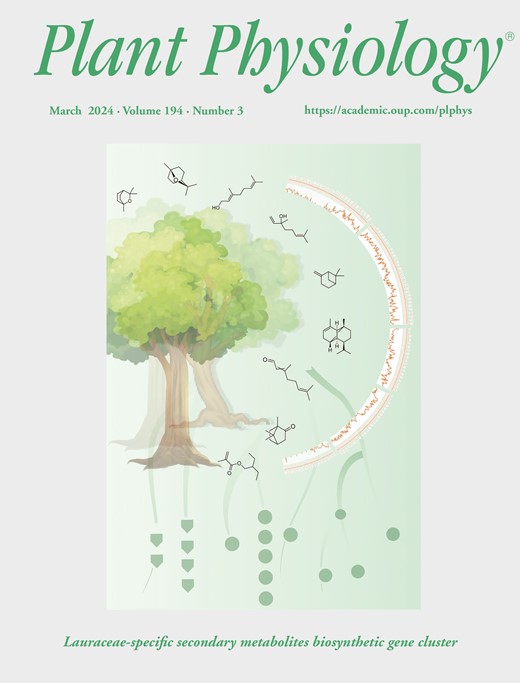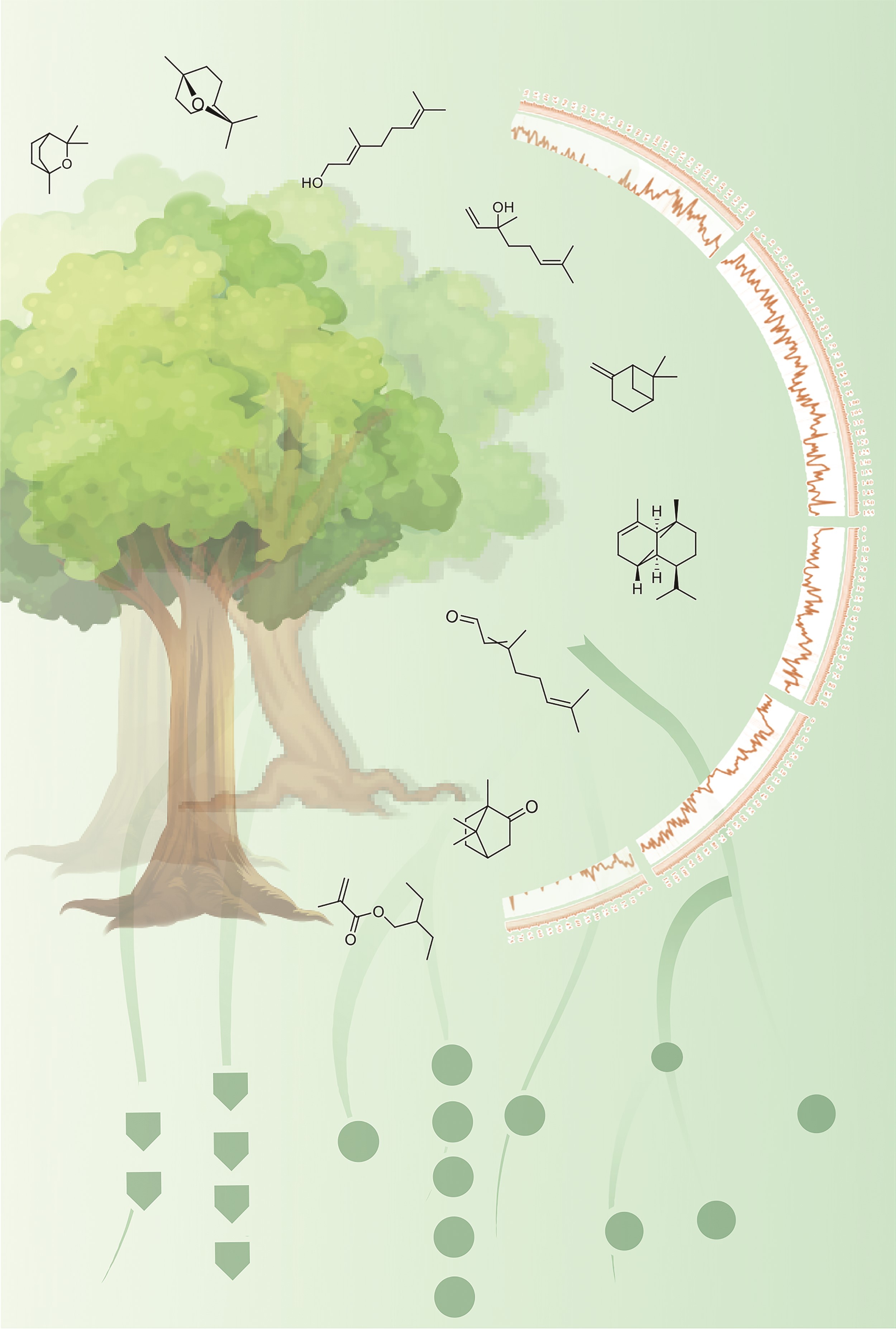
Cover image

Volume 194, Issue 3, March 2024
Thank You to Reviewers and Editors
Thank you to Reviewers and Editors 2023
News and Views
Multifactor agitation: Several minor stresses severely compromise crop growth when combined
Spotlight on overlooked lignin monomers: Hydroxycinnamaldehydes
The antagonistic dance between two ER-shaping proteins in plant cells
Double trouble: Compound effects of heat and drought stress on carbon assimilation
HI from the Sky: Estimating harvest index from UAVs combined with machine learning
A high-yielding recipe: Cytokinin signaling in soybean roots affects phosphorus uptake efficiency and crop production
Smells like lemons: MYB-ADH gene cluster regulates citral biosynthesis in Litsea cubeba
Exploring the genetic architecture of specialized metabolism in Arabidopsis seeds
How to make green and purple from gold
A balancing act: ERFVII feedback loops finetune the flooding stress response
DUFfers can be useful—some even save energy! DUF581-9 negatively regulates the key energy sensor SnRK1
How model guided photosynthetic bioengineering can help to feed the world
In the face of climate change, will trees be…shorter?
Letter
Breakthrough Technologies, Tools and Resources
Mutating the maternal haploid inducer gene CsDMP in cucumber produces haploids in planta
Mutation of DOMAIN OF UNKNOWN FUNCTION 679 MEMBRANE PROTEIN in cucumber induces in vivo maternal haploids and suggests prospects for cucurbit breeding.
In vivo maternal haploid induction system in cotton
The ghdmp mutant of cotton, generated through the CRISPR system, exhibits a haploid induction rate of 1.06% in F1 progeny as the haploid inducer line.
Genes and Development
Two open reading frames of Rht-B1b acting as brake and throttle contributed to wheat Green Revolution
The 5′-open reading frame (ORF) acts as an upstream ORF to restrict overaccumulation of the 3′-ORF encoding protein of the Reduced height-B1b gene to moderately reduce plant height in wheat.
m-Type thioredoxin regulates cytochrome b6f complex of photosynthesis
Depleting m-type thioredoxin disrupts plant cell redox, impacting cytochrome b6f in photosynthesis, hindering photosynthesis, and stunting growth.
Metabolism
n-Alkane 13C/12C indicates differential metabolic controls of fatty lipid chain extension in C3 and C4 grasses
Fundamental differences in metabolic control of fatty acids chain extension are reflected in the contrasting carbon isotopic composition profiles of C3 and C4 grasses.
Update
Breakthrough Technologies, Tools and Resources
Application of new breeding techniques in fruit trees
Topical Review
Genes and Development
Growth regulation by apyrases: Insights from altering their expression level in different organisms
The genetically enhanced expression of certain apyrases in yeast and in multiple different plants promotes the growth of these organisms.
Signaling and Response
CLAVATA signaling in plant–environment interactions
Plants employ signaling peptides and their cognate receptors to dynamically respond to diverse environmental cues.
Research Report
Signaling and Response
The effects of multifactorial stress combination on rice and maize
Research Article
Biochemistry, Biophysics, and Structural Biology
Hydroxycinnamaldehyde-derived benzofuran components in lignins
Newly discovered hydroxycinnamaldehyde-derived benzofuran components, structurally validated in various lignins, have mechanistic ramifications for lignification.
Phycobilisome protein ApcG interacts with PSII and regulates energy transfer in Synechocystis
The phycobilisome protein ApcG interacts specifically with PSII regulating energy transfer to PSI by the phosphorylation of ApcG in its positively charged domain.
Function of iron-stress-induced protein A in cyanobacterial cells with monomeric and trimeric photosystem I
The abundance of iron-stress-induced protein A and its light-harvesting capability in vivo depends on the oligomeric state of photosystem I in the cyanobacterium Synechocystis sp. PCC 6803.
Breakthrough Technologies, Tools and Resources
Detection and editing of the updated Arabidopsis plastid- and mitochondrial-encoded proteomes through PeptideAtlas
Large-scale analysis of millions of publicly available raw MS data in PeptideAtlas determines the editing status of the updated Arabidopsis plastid- and mitochondrial-encoded proteomes.
Cell Biology
Arabidopsis reticulons inhibit ROOT HAIR DEFECTIVE3 to form a stable tubular endoplasmic reticulum network
In Arabidopsis, reticulon proteins negatively regulate the endoplasmic reticulum (ER) fusion activity of ROOT HAIR DEFECTIVE3 to ensure the formation of a stable tubular ER network.
Potato virus Y viral protein 6K1 inhibits the interaction between defense proteins during virus infection
R-SNARE protein YKT61 mediates root apical meristem cell division via BRASSINOSTEROID-INSENSITIVE1 recycling
Arabidopsis atypical R-SNARE protein YKT61 plays a key role in brassinosteroid (BR)–mediated root development by modulating the dynamic targeting of the BR receptor BRASSINOSTEROID-INSENSITIVE1.
The extracellular vesicle proteomes of Sorghum bicolor and Arabidopsis thaliana are partially conserved
Extracellular vesicles (EVs) isolated from sorghum have a heterogeneous morphology and contain proteins also found in isolated Arabidopsis EVs, including the commonly used marker PENETRATION1.
Ecophysiology and Sustainability
Mesophyll conductance limits photosynthesis in fluctuating light under combined drought and heat stresses
Compound stresses of drought and heat inhibit photosynthesis through restricting mesophyll conductance.
Genes and Development
Faba bean and pea harvest index estimations using aerial-based multimodal data and machine learning algorithms
Multiple affordable aerial-based sensors can be used to estimate the harvest index of faba bean and pea with an ensemble Bayesian model averaging algorithm.
Soybean type-B response regulator GmRR1 mediates phosphorus uptake and yield by modifying root architecture
A soybean type-B response regulator adjusts root structure to enhance plant phosphorus uptake efficiency and yield.
Rice ILI atypical bHLH transcription factors antagonize OsbHLH157/OsbHLH158 during brassinosteroid signaling
INCREASED LEAF INCLINATION atypical bHLH transcription factors play indispensable roles in maintaining rice architecture through brassinosteroid signaling by counteracting OsbHLH157 and OsbHLH158.
Functional divergence of Arabidopsis REPRESSOR OF UV-B PHOTOMORPHOGENESIS 1 and 2 in repression of flowering
Arabidopsis proteins REPRESSOR OF UV-B PHOTOMORPHOGENESIS 1 and 2 have distinct functions in repressing flowering under short days due to differences in coding and regulatory sequences.
Transcription factors PuPRE6/PuMYB12 and histone deacetylase PuHDAC9-like regulate sucrose levels in pear
Transcriptional and epigenetic regulation of a sucrose transporter gene underlies sucrose accumulation in pear fruit.
DEFECTIVE KERNEL 56 functions in mitochondrial RNA editing and maize seed development
An E subgroup pentatricopeptide repeat protein recruits a trans deaminase during mitochondrial RNA editing and plays an essential role in maize kernel development.
OROSOMUCOID PROTEIN 1 regulation of sphingolipid synthesis is required for nodulation in Aeschynomene evenia
OROSOMUCOID PROTEIN 1, a key regulator of sphingolipid biosynthesis, is essential for the establishment of the nitrogen-fixing symbiosis in the legume Aeschynomene evenia.
Immunophilin FKB20-2 participates in oligomerization of Photosystem I in Chlamydomonas
FKB20-2 interacts with PSI small subunit PsaG in thylakoid lumen, ensuring the accumulation of PSI complexes and influencing the high light tolerance of Chlamydomonas.
Membranes, Transport, and Bioenergetics
Chloroplast phosphate transporter CrPHT4-7 regulates phosphate homeostasis and photosynthesis in Chlamydomonas
A Chlamydomonas reinhardtii phosphate transporter localizes in the chloroplast envelope membrane and contributes to maintaining phosphate homeostasis and photosynthesis.
Metabolism
Arabidopsis FIBRILLIN6 influences carotenoid biosynthesis by directly promoting phytoene synthase activity
Binding of FIBRILLIN6 to the carotenoid biosynthetic enzyme phytoene synthase promotes carotenogenesis in bacteria and chloroplasts.
Alcohol dehydrogenases regulated by a MYB44 transcription factor underlie Lauraceae citral biosynthesis
Lauraceae plants are abundant in citral due to the formation of lineage-specific clusters of terpenoid synthesis genes, which include transcription factor and modifying enzymes.
Anionic lipids facilitate membrane development and protochlorophyllide biosynthesis in etioplasts
Negatively charged phospholipid and sulfur-containing glycolipids facilitate internal membrane formation and synthesis of chlorophyll intermediates in chloroplast precursors of dark-grown seedlings.
Genome-wide association studies identify loci controlling specialized seed metabolites in Arabidopsis
Genome-wide association studies reveal loci controlling specialized seed metabolites in Arabidopsis, including glucosinolates, flavonoids, and unknown sulfur-containing compounds, providing a rich data set for future studies.
Signaling and Response
PSEUDO-ETIOLATION IN LIGHT proteins reduce greening by binding GLK transcription factors
PSEUDO-ETIOLATION IN LIGHT proteins influence chlorophyll and anthocyanin content, chloroplast size, growth, abscisic acid responses, and the expression of diverse genes in Arabidopsis.
Group VII ethylene response factors forming distinct regulatory loops mediate submergence responses
Three Group VII ethylene response factors form a refined regulatory loop involving transcriptional and protein stability controls in the submergence stress response in Brachypodium.
Protist ubiquitin ligase effector PbE3-2 targets cysteine protease RD21A to impede plant immunity
The protist-secreted E3 ubiquitin ligases PbE3-2, PbE3-3, and PbE3-4 interacted with and ubiquitinated host immune-associated cysteine protease RD21A to impede host immunity.
Oomycete pathogen pectin acetylesterase targets host lipid transfer protein to reduce salicylic acid signaling
The Peronophythora litchii pectin acetylesterase PAE5 suppresses the plant salicylic acid–related immune signaling by interacting with litchi lipid transfer protein and promoting its destabilization.
Transcription factors BZR2/MYC2 modulate brassinosteroid and jasmonic acid crosstalk during pear dormancy
Brassinosteroids and jasmonic acid promote pear dormancy release by the gibberellin biosynthesis pathway to neutralize partial chilling requirements.
Transcription factor OsMYB30 increases trehalose content to inhibit α-amylase and seed germination at low temperature
Low temperature increases the abundance of a transcription factor, which activates the biosynthesis of trehalose and consequently inhibits seed germination by impeding α-amylase activity in rice.
Calcium regulation of the Arabidopsis Na+/K+ transporter HKT1;1 improves seed germination under salt stress
Calcium optimizes K+ levels in germinating seedlings under salt stress by promoting radicle-focused expression of the Na+/K+ transporter HKT1;1.
DOMAIN OF UNKNOWN FUNCTION581-9 negatively regulates SnRK1 kinase activity
DOMAIN OF UNKNOWN FUNCTION581-9 binds to the catalytic SUCROSE NONFERMENTING RELATED KINASE1 α subunit to prevent its activation by upstream phosphorylation.
HD–Zip I protein LlHOX6 antagonizes homeobox protein LlHB16 to attenuate basal thermotolerance in lily
Lily HD–Zip I protein LlHOX6 interacts with LlHB16 to limit its transactivation ability for LlHSFA2 and LlMBF1c and its autoactivation, thereby antagonizing the establishment of thermotolerance.
Long small RNA76113 targets CYCLIC NUCLEOTIDE-GATED ION CHANNEL 5 to repress disease resistance in rice
Long small RNA76113 inhibits immune responses in rice (Oryza sativa) by suppressing the calcium signaling regulator CYCLIC NUCLEOTIDE-GATED ION CHANNEL 5.














































